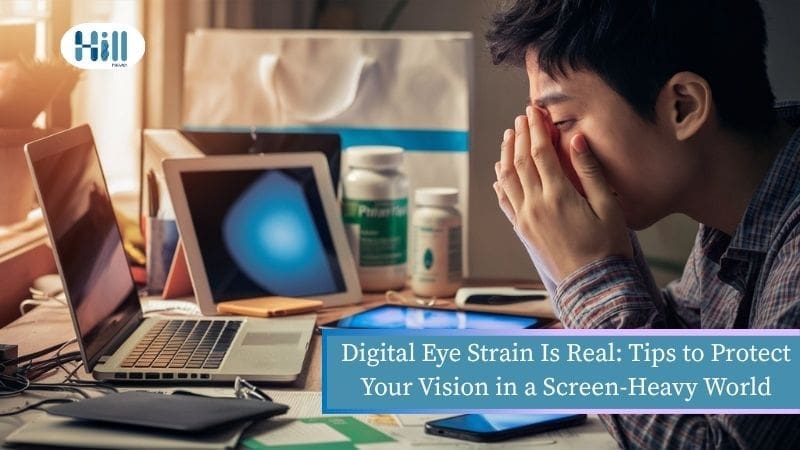
In today’s hyper-connected era, digital screens are nearly impossible to avoid. From morning emails to late-night scrolling, our eyes are constantly working overtime. As a result, more people are reporting symptoms associated with digital eye strain, also known as computer vision syndrome.
If you’ve experienced tired eyes, headaches, blurred vision, or neck pain after a long day of screen time—you’re not alone. This article explores what digital eye strain is, how it affects your eye health, and most importantly, how you can prevent digital eye strain with simple strategies, lifestyle changes, and supportive products.
What is Digital Eye Strain?
Digital eye strain refers to a group of eye and vision-related problems that result from prolonged use of computers, tablets, e-readers, and smartphones. This condition affects both adults and children due to increased screen time at work, school, and home.
According to the American Optometric Association, the average American worker spends about 7 hours a day on the computer, and this number is only rising with remote work and online learning.
Common Symptoms of Digital Eye Strain
- Blurred vision
- Dry eyes
- Red or irritated eyes
- Headaches
- Neck and shoulder pain
- Difficulty focusing
- Increased light sensitivity
These symptoms of digital eye strain may worsen with poor lighting, incorrect viewing distances, and poor posture—factors commonly ignored in everyday screen use.
Why Digital Eye Strain Happens
When we use digital devices, our eyes must constantly focus and refocus. Screens often have glare, flicker, and blue light, which increase the workload on our visual system. Unlike reading a book, digital screens involve dynamic text, shifting light levels, and frequent visual changes.
Key Triggers Include:
- Reduced blinking rate (you blink 66% less when staring at screens)
- Blue light exposure from LEDs
- Poor ergonomic desk setup
- Incorrect screen brightness and glare
- Not following the 20-20-20 rule
- Top Tips to Prevent Digital Eye Strain
Whether you’re working from home, studying, or just catching up on social media, you can take steps to reduce eye strain from screens. Here are proven methods to protect your vision in a screen-heavy world:
1. Follow the 20-20-20 Rule
One of the simplest and most effective tips to combat digital eye strain is the 20-20-20 rule. Every 20 minutes, look at something 20 feet away for at least 20 seconds. This short break allows your eye muscles to relax and helps prevent fatigue.
Pro Tip: Set a reminder or use a screen time management app to help you stay consistent.
2. Blink More Often & Try Blinking Exercises
When staring at a screen, we tend to blink less, leading to dry and irritated eyes. Conscious blinking helps moisten the eyes and flush out debris.
Blinking exercises for eye strain:
- Slowly close your eyes for 2 seconds.
- Squeeze your eyelids together gently.
- Open and repeat 5–10 times per session.
This simple exercise can restore natural tear film and reduce symptoms of digital eye strain.
3. Adjust Screen Brightness for Eye Comfort
Too much brightness or excessive contrast can intensify screen fatigue. Your screen should match the brightness of your surroundings.
- Use the auto-brightness feature or reduce brightness manually.
- Enable dark mode when appropriate.
- Adjust text size for easy readability.
Also, consider increasing contrast to minimize strain.
4. Use Blue Light Glasses
Blue light glasses are specially designed to filter out high-energy visible (HEV) blue light emitted by screens. This can reduce glare, improve contrast, and protect against potential retinal damage.
Some studies suggest that using blue light glasses can also help improve sleep by supporting natural melatonin production, which blue light typically disrupts.
5. Set Up Ergonomic Desk for Eye Health
An ergonomic desk setup for eye health ensures your eyes, neck, and back stay in alignment. Here’s how:
- Place your screen about 20–28 inches from your eyes.
- The top of the monitor should be slightly below eye level.
- Use a chair that supports your back and promotes posture upright.
Keeping good ergonomics reduces physical strain and prevents secondary symptoms of digital eye strain.
6. Use the Right Lighting
The best lighting for computer work is soft, indirect, and evenly distributed. Avoid working under harsh fluorescent lights or in dim environments.
- Use anti-glare screens or filters.
- Position lights besides, not behind, your monitor.
- Close curtains or shades if sunlight hits your screen directly.
Proper lighting dramatically reduces screen glare, one of the leading contributors to eye strain from screens.
7. Eye Exercises for Screen Users
Regular eye exercises can strengthen your eye muscles and improve focus flexibility. Here are a few exercises to try:
- Palming: Rub your hands together and cup them over your closed eyes for 30 seconds.
- Eye rolling: Slowly roll your eyes clockwise, then counterclockwise.
- Focus shift: Hold your thumb a few inches from your face and focus on it. Then shift your focus to something farther away.
Doing these a few times a day can help relieve tension and prevent digital eye strain.
8. Limit Screen Time When Possible
We know it’s easier said than done, but managing screen time and eye health go together. Use app timers, schedule breaks, and embrace tech-free activities like reading a book, walking, or listening to music.
Creating screen-free zones, especially before bedtime, can also improve sleep and reduce the cumulative impact of digital eye strain.
Natural Supplements to Support Eye Health
In addition to lifestyle changes, certain supplements may help protect your eyes from screen-related damage:
1. Lutein & Zeaxanthin
These antioxidants are found in the retina and protect against blue light damage. Found in leafy greens or as over-the-counter supplements.
2. Omega-3 Fatty Acids
Omega-3s support healthy tear production and reduce dry eyes—a common symptom of digital eye strain.
3. Vitamin A
Essential for retinal health and night vision, Vitamin A also keeps the surface of the eye (cornea) moist.
4. Zinc
Zinc plays a critical role in transporting Vitamin A from the liver to the retina, helping with visual pigment formation.
Talk to a pharmacist or eye care professional at HILL PHARMACY before starting any supplement to ensure its suitable for your needs.
When to See a Specialist
If your digital eye strain symptoms persist despite preventive measures, consult an optometrist. You may need prescription glasses designed specifically for computer use. Untreated symptoms can worsen over time and affect productivity and overall wellness.
- Screen Smarter, Not Harder
Digital eye strain is a growing concern in today’s digital world, but it doesn’t have to impact your vision or quality of life. By taking proactive steps—like following the 20-20-20 rule, using blue light glasses, optimizing your workspace, and supporting your eyes with good nutrition—you can stay productive without compromising your eye health.
- Final Thoughts
Protecting your eyes from digital eye strain is not just about reducing discomfort—it’s about preserving your vision for the long term. Whether you’re a student, a professional, or someone who enjoys screen time for entertainment, small changes can lead to big improvements.
Visit HILL PHARMACY for expert advice on supplements, screen protection products, and eye care essentials. Your eyes deserve better care in the screen-heavy world we live in today.






